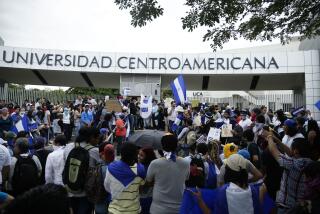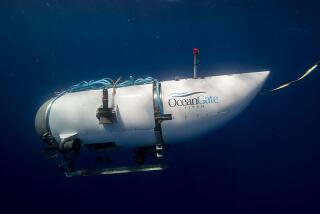Nicaragua: A hike up the active volcano Concepcion
- Share via
Reporting from Altagracia, Nicaragua — On the road south from the international airport in Managua, Nicaragua swooshes by, unfurling in buzzing, humid green. Fields of swaying banana trees recede from the road in rows, the shaggy fronds bouncing against a searing blue sky.
I look south toward the twin conical peaks of Concepción and Maderas hovering over the horizon. It is Concepción that worries me. It is the active volcano I had committed to scaling.
Volcán Concepción towers 5,280 feet up from Lake Nicaragua, Central America’s largest lake. (The lake is also known as Lake Cocibolca, the cha-cha-line name I prefer: co-ci-bol-ca — hey!).
The volcano and its neighbor, Volcán Maderas (4,573 feet) make up the island of Ometepe, meaning “between two hills” in Nahuatl, the indigenous language of the island.
Maderas is dormant, but Concepción sporadically unleashes ashy belches or, less commonly, lava flows. Although there hasn’t been a major eruption in more than 50 years, in November 2007, Concepción fired off a column of ash that dispersed as far as Managua, 60 miles northwest, and prompted a series of small earthquakes on the island.
Ometepe isn’t easy to get to. After you take an hourlong ferry ride over the waters that contain the only freshwater sharks in the world, the island feels as isolated and primordial as it really is.
When Nicaragua erupted in civil war in the ‘80s, Ometepe maintained its distance, and there’s an unruffled feel to the island not found elsewhere in the country. I arrived in Ometepe late in the afternoon, checked into a leafy single bungalow in Hotel Central, and met Alan, the Nicaraguan who would escort me and five other hikers on our 12-hour trip.
At 4 the next morning, I was carbo-loading on hot dog buns and guzzling black coffee, the best nourishment our hotel could offer at that hour. We convened in the lobby, decked out in our climbing finest — assorted ensembles of quick-dry, sweat-wicking layers and Gore-Tex. Alan arrived wearing ripped blue jeans, a white “Surf’s Up” T-shirt and Doc Martens.
We set off in dense, humid darkness along a knobby dirt road. As the trail gradually increased in slope and decreased in width, we walked under swaying banana trees and shiny coffee bushes, past homes with turkeys strutting through the yards. As hazy light began to slant through palm fronds, howler monkeys barked at us from the canopy high above.
Small villages popped up sporadically through the dense foliage that flourishes in the rich, volcanic soil. Many of the 38,000 residents of Ometepe make their livelihoods in this soil, harvesting plantains, rice, sugarcane, corn, coffee and bananas.
As we climbed, our posture changed like a reverse time lapse of human development. At first, I charged straight ahead like the Homo erectus I am, but as the terrain got steeper, I slouched, closer and closer to the ground, until I was using my hands as much as my feet. Within an hour, the trail disappeared, and we simply tacked back and forth over the debris accumulated through the long life of a volcano.
Although the view is said to be spectacular from the slope of Concepción, whoever said so had the good fortune to climb on one of the few days when its top half wasn’t shrouded in clouds. I recalled tales I had read of hikers perishing before the Nicaraguan tourism board mandated guide accompaniment in 2006. How could someone get lost on a volcano? I had thought. You just go down. But as the mist enveloped me so completely that I couldn’t hear or see any of my companions, I started to understand.
As we struggled up the exposed, steep face, the leafy Guanacaste trees decreased until all that was left to hold on to was a squat, beefy plant with thick, spiny leaves 2 feet across.
When all traces of green disappeared, I tried to shimmy up the loose volcanic rock on my stomach, an attempt to keep my center of gravity as close as possible to the volcano. It was here — shimmying while gusts of wind pummeled my back — that I started to wonder about this volcano-climbing business.
Suddenly — finally — the slope stopped, dissolved into sulfurous fog. I collapsed on the warm, gritty volcanic ash. A cold, hard wind at my back, the hot volcano beating beneath me, I crept toward the edge of the crater.
Here it is. My big moment. I was about to look into the bowels of hell.
Hell’s bowels sure were white and foggy. No molten lava spitting out — only the lonely swirl of dense fog. This was more a forlorn Mt. Olympus than Satan’s lair.
“Can you ever see lava?” I asked Alan.
He shook his head, then urged us to pack up and begin our five-hour descent. I learned later that the guides were loath to spend more than a few minutes at the crater lip for fear of eructos de ceniza. Ash burps.
To the dismay of my 6-foot frame, our descent slid us back another notch on the evolutionary scale, as we picked our way down on hands and butts in a perverse crab waddle.
By the time we reached stand-up human status, my quads were so far expired that I walked like a bowlegged cow. Ten hours and 55 minutes after our departure, Hotel Central appeared on the horizon. We stumbled to our rooms, where very cold showers washed layers of Concepción down the drain.
And I checked “climb really tall active volcano” off my life list.
More to Read
Sign up for The Wild
We’ll help you find the best places to hike, bike and run, as well as the perfect silent spots for meditation and yoga.
You may occasionally receive promotional content from the Los Angeles Times.






